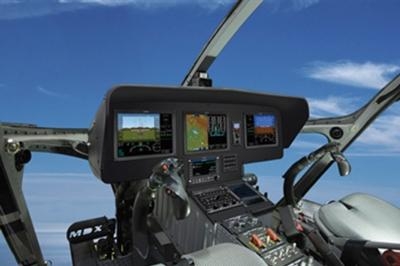Thu, Oct 16, 2014
Program Developments Include Availability Of Fully Functional And Interactive Demonstration Simulator
The Next Generation flight deck for the MD Explorer program has reached what the companies call important milestones.

At the MDHI Mesa facility, final vendor selections for all peripheral avionics systems have been completed and documentation for installation and approval, as well as preliminary systems safety assessments, are in work. System requirements reviews are also ongoing. Of particular note, the engineering prototype helicopter that will be the conforming article for FAA ground and flight test is undergoing a major overhaul / rework to meet the latest designs and standards.
“The Universal Avionics Next Generation flight deck development for the MD Explorer helicopter is advancing as expected,” said Grady Dees, Universal Avionics’ Director of Technical Sales. “Universal Avionics is currently working on finalizing specifications for Engine and CAS development as well as design and construction on the systems integration test rig that will be used for both integrated testing and for demonstration / Human Factors evaluations,” he added.
“This collaboration with Universal Avionics is a reinforcement of MDHI’s commitment to advancing our brand and evolving our product in accordance with the MDHI legacy of advancement through innovation and the infusion of technology-based capabilities,” said Bill James, MD Helicopters’ Chief Technology Officer. “Our joint development with Universal of this Next Generation flight deck is sure to make this already iconic helicopter – known for its proprietary NOTAR technology and superior mission performance – the premier light-twin in our space.”
The Next Generation single-pilot IFR-capable flight deck is available through MDHI for production and retrofit of any MD Explorer helicopter. It is designed to ensure the MD Explorer maintains its position as the most capable, cost-effective and versatile light-twin helicopter available. Specifically tailored for the low altitude operations of rotorcraft, the new flight deck features large format high-resolution LCD displays with LED backlighting. A collective-mounted Cursor Slew Switch allows for a unique “point and click” display control allowing pilots to keep “hands on, head up” during all phases of flight for unprecedented situational awareness..
(Image provided by Universal Avionics)
More News
He Attempted To Restart The Engine Three Times. On The Third Restart Attempt, He Noticed That Flames Were Coming Out From The Right Wing Near The Fuel Cap Analysis: The pilot repor>[...]
Make Sure You NEVER Miss A New Story From Aero-News Network Do you ever feel like you never see posts from a certain person or page on Facebook or Instagram? Here’s how you c>[...]
From 2009 (YouTube Edition): Leading Air Show Performers Give Their Best Advice for Newcomers On December 6th through December 9th, the Paris Las Vegas Hotel hosted over 1,500 air >[...]
Aero Linx: NASA ASRS ASRS captures confidential reports, analyzes the resulting aviation safety data, and disseminates vital information to the aviation community. The ASRS is an i>[...]
“For our inaugural Pylon Racing Seminar in Roswell, we were thrilled to certify 60 pilots across our six closed-course pylon race classes. Not only did this year’s PRS >[...]
 NTSB Final Report: Rutan Long-EZ
NTSB Final Report: Rutan Long-EZ ANN FAQ: Turn On Post Notifications
ANN FAQ: Turn On Post Notifications Classic Aero-TV: ICAS Perspectives - Advice for New Air Show Performers
Classic Aero-TV: ICAS Perspectives - Advice for New Air Show Performers ANN's Daily Aero-Linx (06.28.25)
ANN's Daily Aero-Linx (06.28.25) Aero-News: Quote of the Day (06.28.25)
Aero-News: Quote of the Day (06.28.25)



